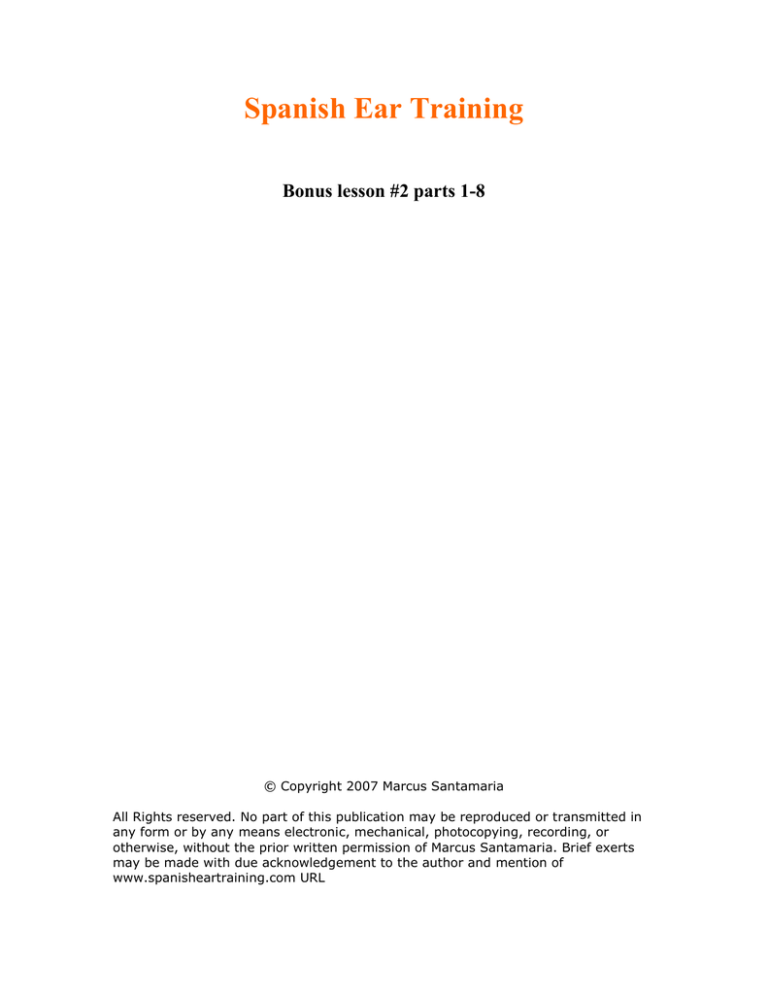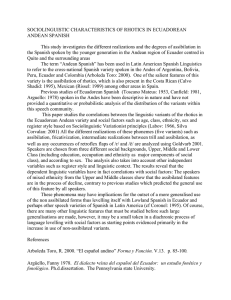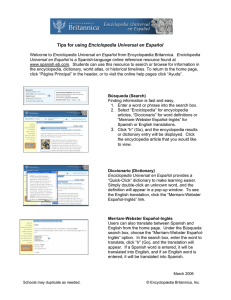How do you say all in spanish
Anuncio

Spanish Ear Training Bonus lesson #2 parts 1-8 © Copyright 2007 Marcus Santamaria All Rights reserved. No part of this publication may be reproduced or transmitted in any form or by any means electronic, mechanical, photocopying, recording, or otherwise, without the prior written permission of Marcus Santamaria. Brief exerts may be made with due acknowledgement to the author and mention of www.spanisheartraining.com URL Bonus lesson #2 part 1 How do you say, all, in Spanish? Todo. Say, all or nothing. Todo o nada. Say, all for me. Todo para mi. Of course, todo, can also be used to mean, everything. Say, everything for me. Todo para mi. If you want to say, everything to me, you say, everything for me. Todo para mi. Mi familia es todo para mi. Say, it is everything to me. Es todo para mi. Say, my family is everything to me. Mi familia es todo para mi. Use the pronoun, ella, and say, she is everything to me. Ella es todo para mi. Again, using the pronoun, say, he is everything to me. El es todo para mi. Say, nothing is everything to me Nada es todo para mi. Say, all for one. Todo para uno. And to say, everybody you just use the plural. Todos. Say, everybody for one. Todos para uno. And like the 3 musketeers say, everybody for one and one for all. Todos para uno y uno para todos. Listen to, Spanish and English. Español e ingles. Did you notice that José Luis said, e, instead of, y, for “and”? This is used when you want to say, and, and the next word starts with “i”. Español e ingles. Say, Spanish and English. Español e ingles. Say, Spanish and Italian. Español e italiano. Say, My friend speaks Mi amigo habla Spanish and Italian español e italiano and English, e ingles, perfectly. perfectamente. Say, my friend speaks Spanish and English, perfectly. Mi amigo habla español e ingles, perfectamente. Say, my friend speaks Spanish and Italian, perfectly. Mi amigo habla español e italiano, perfectamente. Bilingual is very similar to English. Bilingüe Say, bilingual. Bilingüe. Say, is bilingual. Es bilingüe. Say, my friend is bilingual. Mi amigo es bilingüe. He speaks Spanish and English, perfectly. Habla español e ingles, perfectamente. Do you know hou to say, accent? Acento. Listen to, he doesn’t have an accent. No tiene acento. Notice in Spanish, they say, he doesn’t have accent. No tiene acento. Say, he doesn’t have an accent. No tiene acento. Say, my friend is bilingual. Mi amigo es bilingüe. He speaks English, perfectly. Habla ingles, perfectamente. He doesn’t have an accent. No tiene acento. Do you know how to say, strong? Fuerte. In English, we would probably say, a thick accent, but in Spanish, you can convey the same meaning by saying, a strong accent. Acento fuerte. Say, he has a strong accent. Tiene un acento fuerte. Say, my friend speaks English very well Mi amigo habla ingles muy bien but he has a strong accent. pero tiene un acento fuerte. Bonus lesson #2 part 2 You may have come across signs that say, se habla español. Without getting gramatical, I’ll sprinkle ways that “se” is used thoughout these newsletters. In this case “se” is used for the passive voice. It’s the difference between, they speak Spanish, hablan español, and Spanish is spoken. se habla español. Say, Spanish is spoken. Se habla español. In Spanish, to say, Spanish is spoken here, it’s most common to use the reverse word order and say, here, Spanish is spoken. Aquí se habla español. Say, here, Spanish is spoken. Aquí se habla español. Do you know how to say, country? Pais. Say, countries. Países. Say, in 21 countries. En veinte un países. Say, Spanish is spoken in 21 countries. Se habla español en veinte un países. Let’s mention some of those countries and you can practice pronouncing the names of the countries where Spanish is spoken. Say, Spanish is spoken in Puerto Rico. Se habla español en Puerto Rico. Say, Spanish is spoken in Guatemala. Se habla español en Guatemala. Say, Spanish is spoken in Uraguay. Se habla español en Uraguay. Say, Spanish is spoken in Argentina. Se habla español en Argentina. Say, Spanish is spoken in Costa Rica. Se habla español en Costa Rica. Say, Spanish is spoken in Panama. Se habla español en Panamá. Say, Spanish is spoken in Colombia. Se habla español en Colombia. Say, Spanish is spoken in Cuba. Se habla español en Cuba. Say, Spanish is spoken in Mexico. Se habla español en México. Say, Spanish is spoken in El Salvador. Se habla español en El Salvador. Say, Spanish is spoken in Nicaragua. Se habla español en Nicaragua. Say, Spanish is spoken in Honduras. Se habla español en Honduras. Say, Spanish is spoken in Bolivia. Se habla español en Bolivia. Say, Spanish is spoken in Peru. Se habla español en Perú. Say, Spanish is spoken in Ecuador. Se habla español en Ecuador. Say, Spanish is spoken in Venezuela. Se habla español en Venezuela. Say, Spanish is spoken in Chile. Se habla español en Chile. Say, Spanish is spoken in the Dominican Republic. Se habla español en República Dominicana. Say, Spanish is spoken in Spain. Se habla español en España. Say, Spanish is not spoken in Australia. No se habla español en Australia. Say, Spanish is spoken in Belize. Se habla español en Belice. Bonus lesson #2 part 3 To say, the official language, you can say, the official tongue. Lengua oficial. For, official languge, you can also use, El idioma oficial. Notice that, idioma, although it ends in “a”, is a masculine word. Say, the language. El idioma. Using tongue, say, the official language. La lengua oficial. We’ll continue using, Lengua. Say, the official language is English. La lengua oficial es ingles. Say, Spanish is spoken in Belize Se habla español en Belice but the official language is English. pero la lengua oficial es ingles. In some places, especially Spain, Spanish is refered to as, castillian. Castellano. The language of the castle. El castellano. Say, the castilian is the language. El castellano es la lengua. In Spanish, there are many ways to say, the first langauge. For example, you can say, mother tongue. Lengua materna. Or you can say, idioma materna. You can also say, native tongue. Lengua nativa. Or, Idioma nativo. To keep it consistent, we’ll use, mother tongue, when we want to say, first language. Lengua materna. Say, my first language Mi lengua materna is English. es ingles. Say, my first language is English Mi lengua materna es ingles but I speak pero hablo a lot of Spanish. mucho español. Say, my first language is English Mi lengua materna es ingles but I speak a lot of Spanish. pero hablo mucho español. Do you know how to say, second? Segunda. Listen to, second language. Segunda lengua. Say, second language. Segunda lengua. Say, my second language is Spanish. Mi segunda lengua es español. Say, Spanish is not Español no es my first language. mi lengua materna. It is my second language. Es mi segunda lengua. My first language Mi lengua materna is English. es ingles. Say, Spanish is not my first language. Español no es mi lengua materna. It is my second language. Es mi segunda lengua. My first language is English. Mi lengua materna es ingles. “Romance” is written the same in English as Spanish. How would you say, romance, in Spanish? Romance. Say, romance language. Lengua romance. Say, Spanish is a romance language. Español es una lengua romance. Do you know how to say, French, in Spanish? Frances. Say, the French is a romance language. El frances es una lengua romance. How would you say, Portuguese? Portugués. Say, The Portuguese is a romance language. El portugués es una lengua romance. How do you say, Italian? Italiano. Say, The Italian is a romance language. El italiano es una lengua romance. Say, Spanish is a romance language. Español es una lengua romance. The French, Portugese, and Italian, El frances, el portugués e italiano, also, tambien, are romance languages. son languas romance. Say, Spanish is a romance language. Español es una lengua romance. The french, portugese, italian, El Frances, el portugués e italiano, also, are romance languages. tambien, son lenguas romance. Bonus lesson #2 part 4 In this section, we’ll look at a common error of pronounciation. I know it’s common because I’ve heard a lot of people make these mistakes and I made them for a long time, myself. Listen to, difficult. Difícil. The written word has an accent on the middle “i”. Listen again to, difficult. Difícil. Paying attention to your pronounciation, say, difficult. Difícil. And one more time, with attention on the pronunciation, say, difficult. Difícil. Say, it is difficult Es difícil to comprehend him. comprenderlo. Say, it is difficult to comprehend him. Es difícil comprenderlo. The opposite of difficult is, easy. Fácil. This is another word with an accent. In this case the accent is on the “a”. Fácil. It’s important that you get the pronounciation right with this word. Because if you don’t, you may not be understood. Listen again to, easy. Fácil. Say, easy. Fácil. Say, it is easy Es fácil to read. leer. Say, to read in Spanish. Leer en español. Say, it’s easy. Es fácil. Say, to read in Spanish is easy Leer en español es fácil but pero to read in English leer en ingles is not easy. no es fácil. It’s difficult. Es difícil. Say, it’s not easy, it’s difficult. No es fácil, es difícil. Say, to read in Spanish is easy Leer en español es fácil but to read in English pero leer en ingles is not easy. It’s difficult. no es fácil. Es difícil. Do you know how to say, easier, in Spanish? Más fácil. That’s right. You say, more easy. Más fácil. Say, it is easier. Es más fácil. Say, it is easier to read in Spanish than in English. Es más fácil leer en español que en ingles. How would you say, it’s much easier? Es mucho más fácil. Say, it’s much easier to read in Spanish than English. Es mucho más fácil leer en español que en ingles. Bonus lesson #2 part 5 Say, it is difficult Es difícil to comprehend him. comprenderlo. Say, it is difficult to comprehend him. Es difícil comprenderlo. Say, my friend speaks English very well Mi amigo habla ingles muy bien but he has a strong accent. pero tiene un acento fuerte. It is difficult to comprehend him. Es difícil comprenderlo. Say, my children. Mis hijos. Say, my children are bilingual. Mis hijos son bilingües. How would you say, bilingual dicionary? Diccionario bilingüe. Say, I need a bilingual dictionary. Necesito un diccionario bilingüe. How would you say, many parts? Muchas partes. Say, Spanish is spoken Se habla español in many parts en muchas partes of the United States. de los Estados Unidos. Say, Spanish is spoken in many parts of the United States Se habla español en muchas partes de los Estados Unidos but the official langauge pero la lengua oficial is English. es ingles. Say, Spanish is spoken in many parts of the United States Se habla español en muchas partes de los Estados Unidos but the official langauge is English. pero la lengua oficial es ingles. Say, the first language La lengua materna of my friend is Spanish de mi amigo es español but he speaks English very well. pero habla ingles muy bien. Say,the first language of my friend is Spanish La lengua materna de mi amigo es español but he speaks English very well. pero habla ingles muy bien. Say, Spanish is spoken in many countries. Se habla español en muchos países. listen to, South America. Sudamérica. Say, South America. Sudamérica. In Spanish to say, South American countries or countries in South America, you would say, countries of South America. Países de Sudamérica. Say, South American countries. Países de Sudamérica. Say, many South American countries. Muchos países de Sudamérica. Say, Spanish is spoken many South American countries. Se habla español en muchos países de Sudamérica. How would you say, Spanish is written? Se escribe español. Say, like it is spoken. Como se habla. Say, Spanish is written like it is spoken Se escribe español como se habla but the English pero el ingles is not written no se escribe like it is spoken. como se habla. Say, the English is not written like it is spoken. El ingles no se escribe como se habla. Say, the Spanish is written like it is spoken El español se escribe como se habla but the English is not written like it is spoken. el ingles no se escribe como se habla. That’s why Por eso to read in Spanish leer en español is easier es más fácil than que to read in English. leer en ingles. How would you say, it is more difficult or it is harder? Es más difícil. Say, it is harder to read Es más difícil leer in English than in Spanish. en ingles que en español. Say, it’s harder to read in English than in Spanish. Es más difícil leer en ingles que en español. Bonus lesson #2 part 6 Here’s how you ask what time it is, in Spanish. ¿Qué hora es? So, what you’re saying is, what hour is it? ¿Qué hora es? Ask, what time is it? ¿Qué hora es? Here are some more uses of hour, when referring to time. For example, to say, “bedtime”, you can say, hour of sleep. Hora de dormir. Say bedtime. Hora de dormir. Say, it’s bedtime. Es hora de dormir. How would you say, it’s dinner time? Es hora de cenar. You’ll also hear people talk a lot about, mealtime. Hora de comer. Say, mealtime. Hora de comer. Imagine you’re on the telephone and you ask, can I speak to José? ¿Puedo hablar con José? The person on the other end replies, he’s not here. No está aquí. It’s mealtime. Es hora de comer. Reply, there is no problem. No hay problema. I’m going to call Voy a llamar again, otra vez, later. más tarde. Say, I’m going to call again, later. Voy a llamar otra vez, más tarde. Ask, can I speak to José? ¿Puedo hablar con José? Reply, he’s not here. No está aquí. It’s mealtime. Es hora de comer. There is no problem. No hay problema. I’m going to call again, later. Voy a llamar otra vez, más tarde. See if you can get these right. Say, local time. Hora local. Say, central time. Hora central. To say “daylight saving time” you can say, hour of summer. Hora de verano. And another useful expression is to talk about the peak hour. Hora pico. Which is something you definitely want to avoid, if you go to Mexico City, as a lot of the time, in the peak hour, the Periférico is like a parking lot. Say, peak hour. Hora pico. Say, there is a lot of traffic Hay mucho trafico in the peak hour. en la hora pico. Say, There is a lot of traffic in the peak hour. Hay mucho trafico en la hora pico. When you’re talking about the time, to say, it is one o’clock, you will say, it’s the one. Es la una. But for two o’clock or later you say, they are the two. Son las dos. So to say, it is three o’clock, you say, Son las tres. Say, it is one o’clock. Es la una. Say, it is four o’clock. Son las cuatro. In Spanish, to ask what the time is, you can ask, what hour is it? ¿Qué hora es? Ask, what time is it? ¿Qué hora es? Reply, it is ten o’clock. Son las diez. Ask, what time is it? ¿Qué hora es? Reply, it is eleven o’clock. Son las once. If you want to ask, at what time something will be, as opposed to what the time is now, you ask, at what hour? A qué hora? For example, to ask, “what time the party is”, you ask, at what time is the party? ¿A qué hora es la fiesta? Ask, at what time is the party? ¿A qué hora es la fiesta? In English, we might just ask, when is the party? ¿Cuándo es la fiesta? when we really mean, what time is the party? In Spanish, if you use, when, cuándo, it will be understood as, which day or date, not which hour. Ask, when is the party? ¿Cuándo es la fiesta? Reply, the party is today. La fiesta es hoy. At what time ¿A qué hora does it start? empieza? Ask, at what time does it start? ¿A qué hora empieza? Reply, it starts at six. Empieza a la seis. Ask, when is the appointment? ¿Cuándo es la sita? Reply, the appointment is tomorrow. La sita es mañana. Ask, at what time? ¿A qué hora? Reply, at three o’clock. A las tres. Bonus lesson #2 part 7 When you talk about, country, as in a nation, for example, the United States, England, Spain, you use the word, pais. But if you mean, the country, as in, not in the city, for example, the countryside, you use, el campo So to get out of the city and go to the country you would say, go to the countryside. Ir al campo. Say, we are going to go to the countryside Vamos a ir al campo this weekend. este fin de semana. Say, we are going to go to the countryside this weekend Vamos a ir al campo este fin de semana. Say, I like the countryside. Me gusta el campo. In Spanish to say, all day, you say, all the day. Say, all the day. Todo el día. Remember, “día” is a masculine word. El día. Say, we are going to spend all day Vamos a pasar todo el día in the countryside. en el campo. Do you know how to say, yesterday? Ayer. To say, “all yesterday” or “all day yesterday”, you say, all the day of yesterday. Todo el día de ayer. Say, all yesterday. todo el día de ayer. How would you say, we spend? Pasamos. In Spanish, to say, we spend and we spent, is the same. Pasamos. Say, we spent Pasamos all yesterday todo el día de ayer in the countryside. en el campo. Say, we spent all yesterday in the coutryside Pasamos todo el día de ayer en el campo. The same thing applies to say, all year. You say, all the year. Todo el año. Say, all year. Todo el año. Say, almost all the year. Casi todo el año. Say, we spend almost all the year Pasamos casi todo el año in Spain. en españa. Say, we spend almost all the year in Spain. Pasamos casi todo el año en España. Say, we spend almost all the year in Mexico. Pasamos casi todo el año en México. You may hear this expression, todo el santo día. Literally it means, all the holy day, but it is used the same as we would say in English, all day. Pasamos todo el santo día en casa. Bonus lesson #2 part 8 Do you know how to say, ready? Listo. When talking about being ready, you use the verb, estar, because it’s the form of the verb to be that is used for states of being. To say, it is ready, you say, está listo. Say, it is ready. Está listo. Say, it is not ready. No está listo. Say, everything is ready. Todo está listo. You may expressively hear, Sí, todo listo. Literally, yes, everything is ready, but figuratively, it’s like saying, yes, all set. Sí, todo listo. Say, yes, all set. Sí, todo listo. And you’ll also hear this expression a lot. Todo bien. Literally, you’re saying, all well, but figuratively it’s like saying, everything is fine. Todo bien. Say, everything is fine. Todo bien. Ask, is everything fine? ¿Todo bien? Reply, yes, everything is fine. Sí todo bien. I am ready Estoy listo in order to speak para hablar a lot of Spanish mucho español the next time. la próxima vez. Now, we’re going to use the Spanish subjunctive. Listen to, that I may be able to go. Que vaya. Say, that I may be able to go. Que vaya. In English, we don’t use this structure much. In English, we’d just say, “I go”. But if we’re talking about something in the future that’s a little uncertain, you’ll say, that I may be able to go. Que vaya. Say, the next time that I may be able to go La próxima vez que vaya to Mexico. a México. Say, the next time that I may be able go to Mexico. La próxima vez que vaya a México. Say, the next time that I may be able go to Spain. La próxima vez que vaya a España. Ask, is everything fine? ¿Todo bien? Say, yes, everything fine. Si, todo bien. I am ready in order to speak a lot of Spanish Estoy listo para hablar mucho español the next time that I may be able go to Spain la próxima vez que vaya a España or to Mexico. o a México. I am ready in order to speak a lot of Spanish Estoy listo para hablar mucho español the next time that I may be able go to Spain or to Mexico. la próxima vez que vaya a España o a México. Say, the next time that I may be able go to Miami. La próxima vez que vaya a Miami. Ask, everything fine? ¿Todo bien? Reply, yes, everything fine. Si, todo bien. I am ready in order to speak a lot of Spanish Estoy listo para hablar mucho español the next time that I may be able go to Miami. la próxima vez que vaya a Miami. Goodbye friends. I hope you liked the lesson. Adiós amigos. Espero que les haya gustado esta lección.





